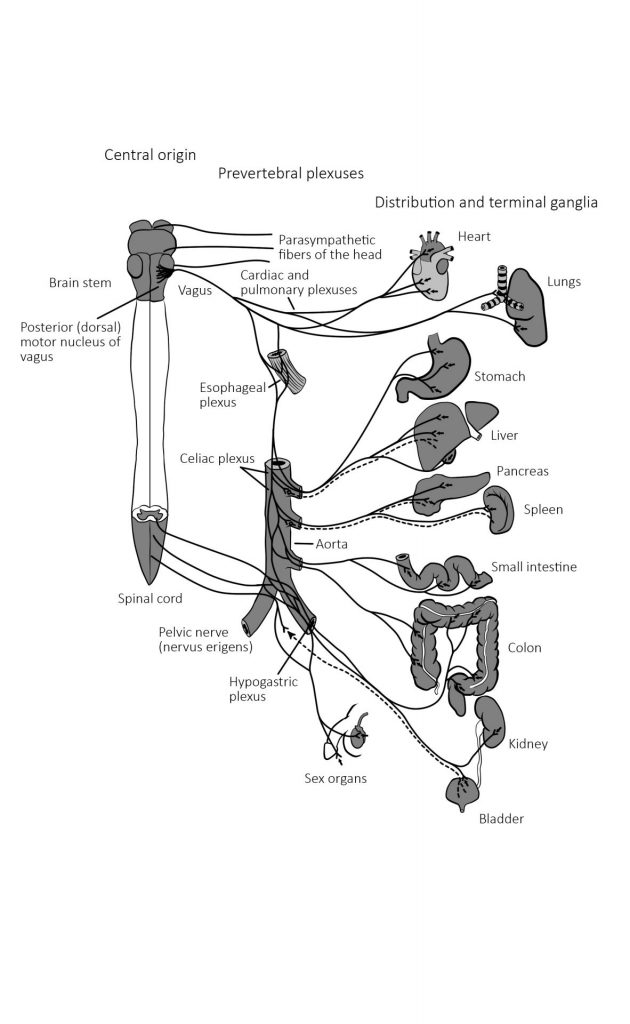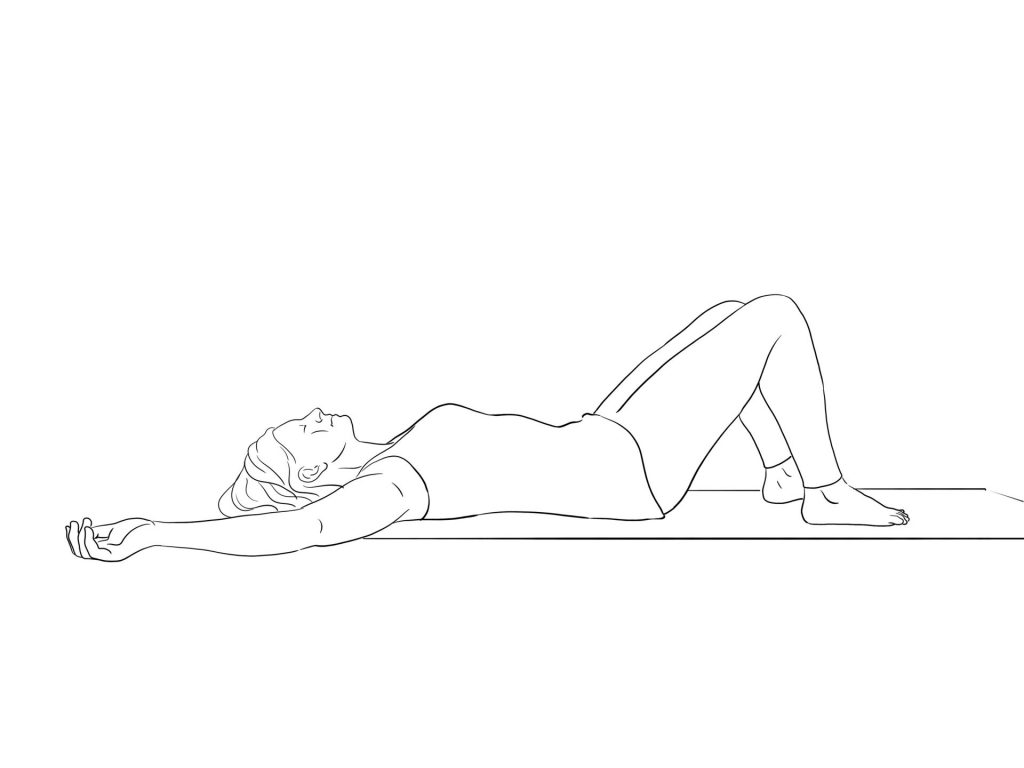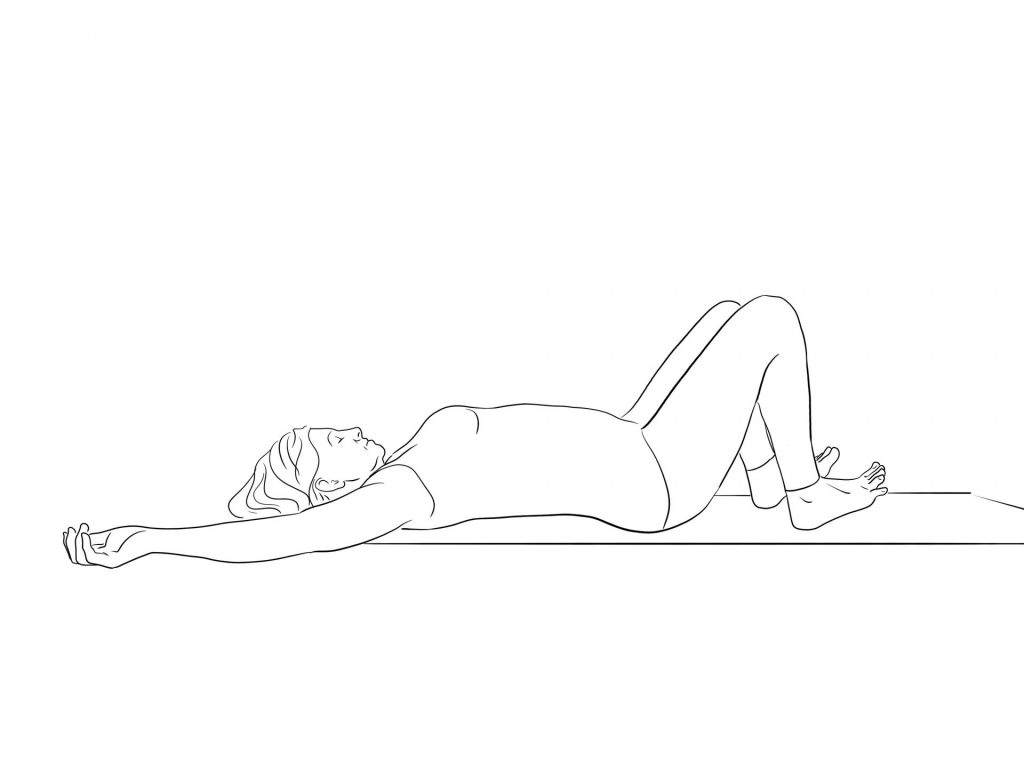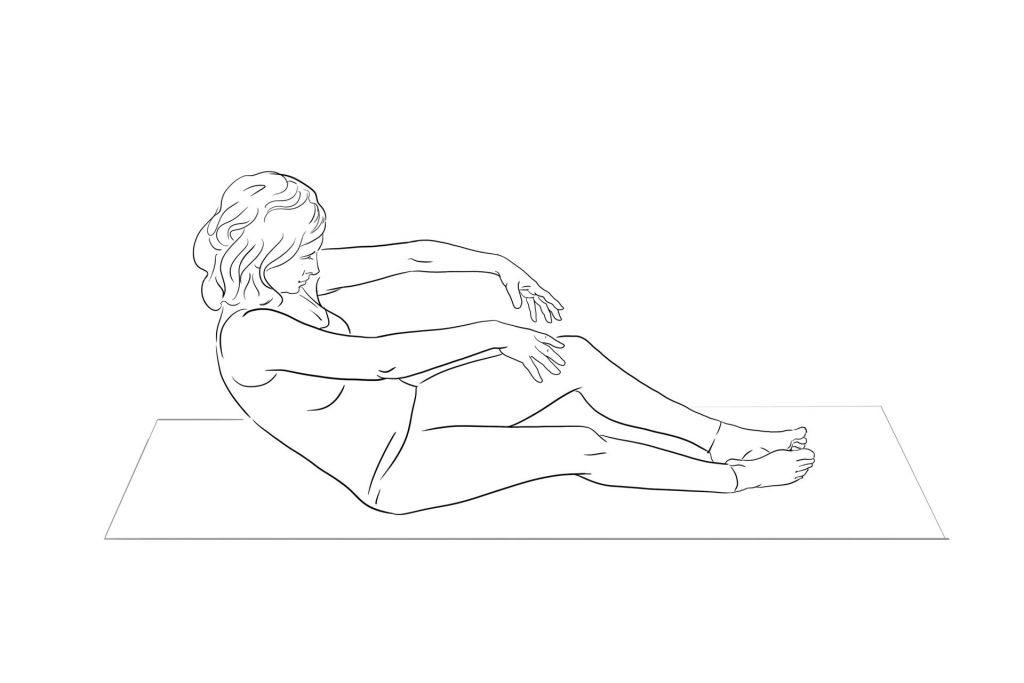
Did you know that unravelling tension through the midline is one of the keys to better digestive health? Charlotte Watts explores how this can be felt physically and emotionally.
Digestive Health and Unravelling Tension through the Midline
In this series on digestive health we have explored how stress and trauma affect our digestive system; and how our posture and movement both influence and are affected by digestive health in parts one, two and three . We now look at how we can support our digestive health by unravelling tension and fascial restrictions by focussing in on the midline.

Calibrated Curves
Our digestive arrangement follows how we stand up; not in a straight line, but rather as a system of calibrated curves. Our primary curves are the ones we are born with – those that curve outwards as protective bony places: heels, sacrum, back of ribs and skull. These curves rise up above each other in ‘ideal’ posture, suspending the weight of the head above the similar weight of the pelvis. Secondary curves develop as we stand upwards against gravity and are softer, fascial places.
The happier our posture in this arrangement, the more calibrated we are with our skull happily weighted above our pelvis. It is here that we can feel calm and settled into our nervous system (including that in the gut) as we don’t need to compensate for tendencies for the head to shift forward of the shoulders.
Intelligent design
This design allows clear communication between the skull and the sacrum; the large, triangular bone at the base of the spine. This is the route for both top-down (brain to body) and bottom-up (body to brain) messages that involve the enteric nervous system in the gut lining and muscles in the pelvis (psoas) and the neck (scalenes) as relays. The tone of both our jaw and eyes at the top of the spine, and the lower back and belly at the bottom are constantly mirroring each other.
Connected via the vagus nerve
One of the key parts of this relay and response through the central axis is the vagus nerve. Vagus means ‘wandering’ as in vagrant or vagabond. This nerve takes a wandering journey to connect so many parts of us.
The vagus is our 10th cranial nerve (in the skull) and part of our older nervous system. In other words, it’s part of our primal patterning. It is the only cranial nerve that reaches down and out of the skull into the body; from the back of the head into the base of the skull down into the solar plexus, from the spine into the digestive and reproductive organs, via the sacrum. The vagus wraps around our heart and core areas via the solar plexus, creating a channel between these seats of compassion and awareness. Anxiety is the vagus nerve disengaging.

Gut Feelings
Twenty per cent of the fibres of the vagus nerve control the organs that ‘maintain’ our bodies – heart, digestion, breathing, glands etc. The other 80 per cent of its fibres send information from gut-to-brain. Its whole channel through brain to pelvis is the route for the skull-sacrum polarity that we can explore through movement and asana. The awareness we can cultivate is tuning into the visceral feelings and gut-instincts that are literally emotional intuitions transferred up to the brain via the vagus. As the vagus picks up on signals moving ‘top-down’ and ‘bottom-up’, there is the opportunity to bring these to consciousness and move through samskaras. In a very real sense, mindful practices can re-wire our minds and full physiological responses through this neuroplasticity.
Skull-sacrum polarity and unravelling tension
Following the vagus route to connect communication between the top and bottom of the spine, there are many ways of viewing this ‘skull-sacrum polarity’. Looking from different viewpoints helps us tune in to our felt experience in ways that make sense to us personally, for example as:
- Gut-brain axis (rather than ‘brain-gut axis’ as most information flows upwards)
- Mouth and anus as our central tube which develops from the same neural tissues
- Jaw and belly expressing stress and emotional upset together
- Physically balancing the similar weights of the head and pelvis
- The main nadi (energy channel) in yoga subtle anatomy; the shushumna nadi that corresponds with the spine
- The spinal tide that can be sensed and supported by a cranio-sacral therapist
- The Siva-Shakti principle from Hindu mythology. The god Siva is believed to reside in the sahasrāra chakra (crown of the head), representing consciousness and the masculine. His consort Shakti resides in the mūlādhāra chakra (root, pelvis), representing the activating power and feminine energy. In other words there is constant communication and attention between the experienced and unconscious. The objective and subjective are part of the dance of life that we feel radiating out from the spine.
- Another of the main nadis is the alambusa nadi, that travels down the front of the spine and in some texts, connects mouth and anus.
With both sleep and digestive issues described in gut-brain axis research as issues of a ‘derailed brain-gut axis’ (Orr WC et al 1997), skull-sacrum polarity is one of our most important guides to supporting digestive health through yoga.
Spinal fluidity for gut-brain flow
When we look at where the vagus nerve connects to all of our internal organs from the skull and sacrum, we can see that motions that undulate or create a wave-like motion through the spine can help smooth messages between these points. Following the natural motion of the breath through the spine can balance cranio-sacral rhythm to help soothing (parasympathetic) nervous system action; reducing whole mind-body tension via gut-brain feedback.

These physical movements have long been associated with improving digestion in many cultural practices. This is seen in Qi Gong and Kundalini yoga. These movements create awakening and fluidity in the abdominal region, massaging the organs and softening the deep hip flexors. This allows us to feel the relationship with the rib cage and the pelvis for postural awareness. We feel the easing of digestive issues through pelvic stability and reducing psoas tension.
Simple spine undulations
The rhythmic pumping of undulating the spine moves fluids from the centre out; squeezing organs, freeing spinal connections, supporting fascial hydration and pliability, lymphatic movement through the groin, abdomen, diaphragm, collarbones and throat, and circulation.
The best-known spine undulation, ‘cat-cow’ pose (marjayasana-bitilasana), suspends this movement between the shoulder and hip joints, allowing free movement up the whole spine and the root. Alternately opening the front and then the back body helps attune us to the differing qualities of these physical and emotional polarities. We can do spine undulations on any plane (lying, sitting, standing etc) but they all follow the same guidance of movement from the breath:
- On the exhalation we open the dorsal or back body – this curls us in (via psoas flexion) and is a gesture of protection paired with the calming, parasympathetic out-breath (can also represent habitual shame, collapse or heart depletion).
- On the energising, sympathetic inhalation we open the ventral front body – this opens us up to meet the world with our soft, vulnerable throat, heart and belly and is a gesture of courage and receptivity.
- The back and front body never truly meet except through the sacral point at the belly, where digestion is most happy in the balance between non-doing and doing.
Through this continuum of opening and closing we find the spinal tide of breath and movement synchronicity. We can see the unfolding of the beginning, middle and end of each breath. We observe the natural pause between them allowing the breath to lead the movement.
Spine undulations with counter neck motion
Floor versions allow us to feel subtler movement through the spine. This is because the hips and shoulders cannot move out of the way. The subtlety can however, help in unravelling the tension in an easeful way.
- From laying with your legs bent and feet hip-width apart (constructive rest position), inhale to arch your back and rise the belly, lifting the waist and moving the tailbone down towards the ground.
- With the exhalation, let the chest and belly drop as lungs empty.
- As the motion becomes free, allow the chin to move down the meet the chest as you breathe in and let it lift to the ceiling as you exhale; tracking a line up and down the back of the skull, head heavy onto the ground.
- When the movement and breath synchronise, you can increase the wave-like effect by lifting the balls of the feet as you inhale and rocking on the feet to lift the heels as you exhale.
This lying motion differs from most spine undulations as it includes the opposite (counter) movement in the cervical (neck) and lumbar (lower) spines and so is extremely freeing for skull-sacrum communication.
Spine undulations to feel emotional tone from the belly to the arms
In an upright undulation, lift up the spine from the ground. Add in a gathering and support effect through the postural muscles. You can follow this up through the abdomen to support and tone the digestive organs. We can feel full pelvic tilts as the root retains sensory contact with the ground or seat. We can tune into the undulation of the tailbone.
- Sitting upright, bend and drop your knees to the side, feet don’t need to be together. Inhale to open the arms and chest, lifting in and up between the shoulder blades.
- On the exhalation, drop the belly backwards and scoop the arms forward as if you are holding a large ball; keeping the arms rounded, hands apart and head dropping fully. As you inhale, come back to the first position, lifting from the belly and heart.
- Move between the two, arm and hand movements fluid and expressive; shoulders soft for less stress in the belly.
Unravelling tension in the midline with ease
It is easy to lead with the chin as we inhale in spine undulations. Try leading with the belly, heart and collarbones. Retain space in the back of the neck and base of the skull. Explore the self-soothing possibilities via the vagus bundle, including a sense of softness in the front brain.
This helps us feel and move through the three main granthis. These are the ‘knots’ or ‘doubts’ we might feel in the perineum (pelvic floor), navel and forehead. Therefore unravelling this tension leads to greater ease.
About Charlotte Watts:

Charlotte Watts is a Senior Yoga Teacher. Charlotte loves explorative, compassionate and somatic yoga practices. She infuses her practice with Qi Gong and Feldenkrais. She teaches classes in Brighton and London. Charlotte also teaches workshops and retreats in the UK and abroad. Charlotte teaches modules for Teaching Yoga for for Digestive Health for Yogacampus. She also teaches on the Yoga Therapy course for The Minded Institute.
Charlotte is an author with many published books, including Yoga Therapy for Digestive Health (Singing Dragon 2018). She is an award-winning nutritionist practising since 2000. Charlotte specialises in stress-related and fatigue conditions and burnout, and digestive issues.










Leave a Reply